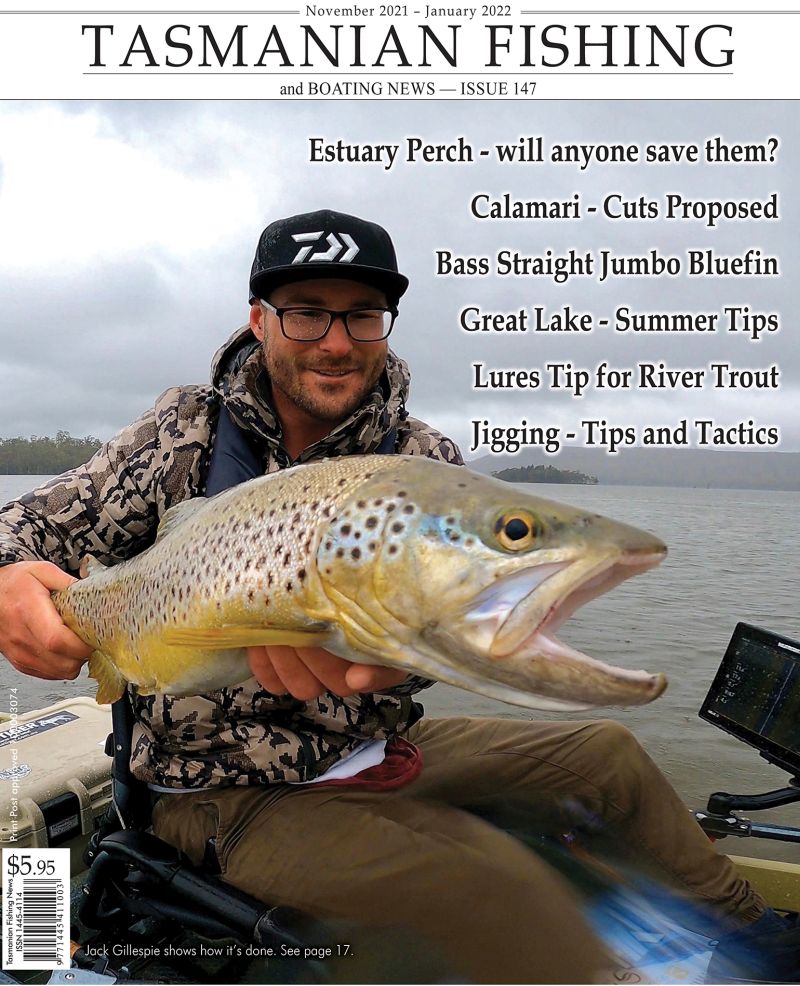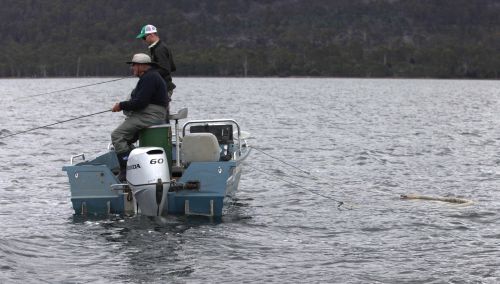Presented from Issue 105, August 2013
Bob is a professional fishing guide and guides for trout and estuary species. Check him out at www.fishwildtasmania.com
There are several things we look for in our early season trout waters. It is still winter and cold, so some of the things to consider are: Altitude as this dictates the water temperature and therefore feeding activity. Food for the fish. Availability of trout food is generally dictated by the quantity and quality of weed beds.
Quantity of fish.
Three waters which I believe fit all three requirements are:
SOUTH - Derwent River
Some of the best early season trout fishing IN Tasmania is found near Hobart in the Derwent River. The Derwent’s seaward limit is about 20K South of Hobart at the Iron Pot, however it is the water above Hobart where trout are taken in good numbers during Spring.
At this time of the year trout feeding on pretty fish are found all over the Derwent, especially from the Tasman Bridge up to the Boyer pulp mill. The best fishing is generally somewhere in between. Pretty fish (Not to be confused with whitebait) are the target food of the trout from August to the end of October and there are dozens of great imitation flies available at local tackle shops. A good imitation is a fur fly with a dark green back and pale under body. Whitebait starts to run up the rivers around the end of September, peaks in October and tapers off in Late November. This run attracts resident trout but also brings with it sea run trout which are legendary in Tasmanian waters.
These fast feeding fish are best located by the sprays of whitebait flying out of the water as the sea runners charge through the bait schools. There are plenty of good whitebait imitations available in Hobart and most will do the job if you can get them in front of a feeding fish.
A boat is handy as it is easy to move from place to place, but there is huge scope for shore based fishing as well. Any protruding point, no matter how small can be a real hot spot.
All methods will be rewarded from bait fishing to soft plastics, lures and fly. Check you local tackle store for the best lures, flies and bait to suit your method. You will also catch flathead on the bottom, bream if you fish really slowly and small Australian salmon. There is a health warning not to eat bream as they are very long-lived and can have a build up of heavy metals.
NORTH - Four Springs
Situated in the North of the State, a short drive from Westbury, off the Bass Highway between Launceston and Devonport. The route to Four Springs is well sign posted from the main street of Westbury.
This is a very rewarding fishery from the start of the season in August through to late November when it can get too warm for trout to feed during the day.
Due to its low altitude, it has the best early season hatches with midge on any decent day and the first of the dun hatches from early October when you can find trophy trout surface feeding well before any other waters fires up.
Four Springs is purely a recreational water which is stocked with browns and rainbow trout yielding fish of three to four kilograms. Both the South and North ends as well as the East side of the lake are shallow and big trout can be found there early season. Fly anglers will need to fish wet flies during the early months of August and September so try a fur fly, dark woolly bugger or a damsel nymph all fished very slowly. Best results are usually on a type three sinking line.
Although drifting using a drogue is common, better touch, and results can often be had by mooring the boat and moving a few metres every 10-15 minutes.
Good plastics to try - either trolling or casting are Yep black and gold Flappers, Red Rascal split tail Yeps; Berkley pumpkinseed minnows, Berkley black and gold T-Tails. Baits - anything from worms to mudeyes and grubs are all good. For those chasing rainbows, Powerbait does the trick.
CENTRAL Highlands - Woods Lake
If you want to find good big feeding trout in the Highlands during the early season months, then Woods Lake is one great option. At 740m above sea level and well protected in a valley it is one of the Central Highlands lower altitude waters with its neighbour, Arthurs Lake at 960m. This water remains at a slightly higher temperature keeping bugs active and trout feeding right from the start of the season.
In August and September you will need to be prepared for cold weather and fish a wet fly. Try a floating line in the shallow waters with a fur fly that resembles galaxias or a dark woolly bugger with some green on it. For deeper water use varied rate of sinking lines and the same wet flies.
Midge will hatch on any fine still day during September to October and Woods lake trout will readily rise to them if the larger chironomid are amongst the hatch. From October to the end of Nov stone fly will be the dominant hatch and it is great to see trout rising on any water with plenty of these flies Be ready if it calms out as the stonefly will go out and hatch by the thousands bringing most fish up to surface feed however this is like rocking horse manure, its pretty rare.
Bob McKinley




